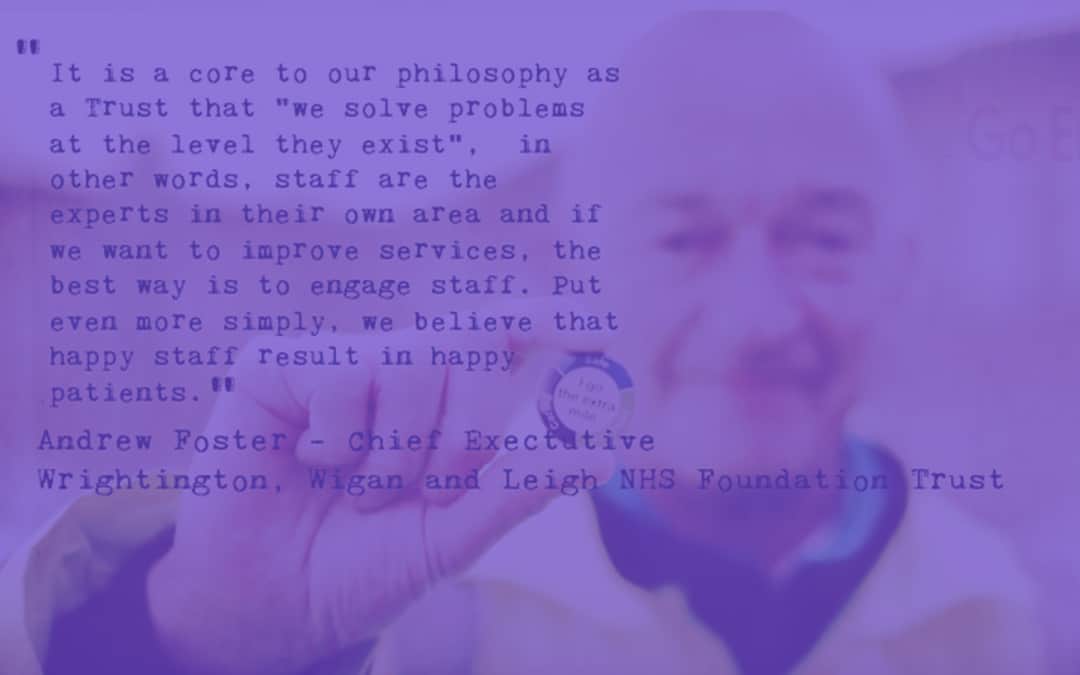Background
Imagine an organisation where good culture and employee engagement is literally a case of life or death. In the UK’s national health service, the NHS, this is a reality, with research showing that poor staff morale and culture can have a damaging effect on patient care. And poor patient care can mean increased infections and patient death.
Back in 2011, this was the scenario faced by Wrightington, Wigan and Leigh NHS Foundation Trust (WWL). It was one of the worst performing trusts in the UK for employee engagement, and this was being reflected in deaths and infection rates. As a major acute trust with three hospital sites serving the people of Wigan and Leigh, it had to address the issue urgently. With so much riding on the outcomes, WWL couldn’t afford to go with the latest fad or unproven methods. It needed to understand the science behind employee engagement and design interventions that would provide a continuous improvement and long-term sustainability. So it took a rigorous, evidence-based approach.
"Understanding the science behind employee engagement and designing sustainable interventions"
Approach
In 2012 West and Dawson had published research identifying that if employee engagement and culture within the NHS was positive, this had a positive impact on patient care outcomes. So, the trust set a challenging target: to move its engagement from the bottom 20% to the top 10% of most engaged NHS Trusts, with the ultimate aim to deliver significant improvements in patient care.
 To achieve this, a team led by an occupational psychologist at WWL designed Go Engage, an employee engagement model underpinned by psychological research and theory and focused on nine employee engagement enablers (predictors of engagement) and seven indicators of engagement itself (three ‘feelings’ and four ‘behaviours’). The model was turned into an IT platform that surveys employees, undertakes comprehensive data analytics and produces intelligence dashboards. Employees are surveyed every three months and the dashboards can quickly identify employees at risk in any one area and the right interventions can be designed and implemented swiftly. In addition to the organisational approach of pulse surveys WWL also introduced its Pioneer Teams Programme where individual teams are empowered to take charge of their own engagement.
To achieve this, a team led by an occupational psychologist at WWL designed Go Engage, an employee engagement model underpinned by psychological research and theory and focused on nine employee engagement enablers (predictors of engagement) and seven indicators of engagement itself (three ‘feelings’ and four ‘behaviours’). The model was turned into an IT platform that surveys employees, undertakes comprehensive data analytics and produces intelligence dashboards. Employees are surveyed every three months and the dashboards can quickly identify employees at risk in any one area and the right interventions can be designed and implemented swiftly. In addition to the organisational approach of pulse surveys WWL also introduced its Pioneer Teams Programme where individual teams are empowered to take charge of their own engagement.
Outcome
These targeted interventions have not only increased engagement (WWL reached its target to be in the top 10% of NHS Trusts in 2014 and has sustained this), and increased productivity but they have reduced sickness costs and, most importantly, had a huge impact on patient care. WWL achieved an 86% reduction in harms to patients between 2007/2008 and 2014/2015, a 93% reduction in C Difficile cases, its A&E was one of the few NHS Trusts to achieve the 95% target in 2015/16 and it has been awarded cleanest hospital for several years since 2011, including in 2019.
It has not stopped there though. WWL is now helping others to develop positive cultures. It has partnered with 13 NHS Trusts and is speaking with several other public sector organisations. With features and enhancements on the way, it plans to take Go Engage to the private sector. A true example of modelling the change it wants to see – internally and externally.

